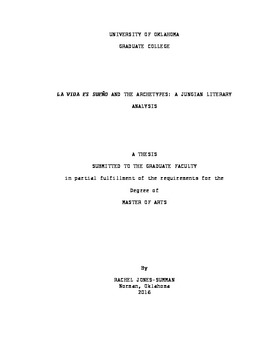| dc.contributor.advisor | Lauer, A. Robert | |
| dc.contributor.author | Jones-Summan, Rachel | |
| dc.date.accessioned | 2016-12-21T17:16:42Z | |
| dc.date.available | 2016-12-21T17:16:42Z | |
| dc.date.issued | 2016-12 | |
| dc.identifier.uri | https://hdl.handle.net/11244/47114 | |
| dc.description.abstract | To date there have been no comprehensive Jungian analyses of La vida es sueño, despite the play’s extensive bibliography. A Jungian analysis provides a novel perspective on the fraught relationship between Basilio and Segismundo as the ego-consciousness’s rejection of the contents of the personal unconscious, typified in Segismundo as the Child-hero Basilio represses. Further, a consideration of Violante as the archetypal Great Mother demonstrates her importance to Rosaura and to the play as a whole, and an analysis of Rosaura’s development illustrates a successful individuation through a consolidation of the anima and animus. Finally, Clotaldo as the Wise Old Man gives counsel to Segismundo and Basilio, and Clarin the Trickster personifies the contents of Basilio’s shadow and is ultimately instrumental in the king’s redemption. It is hoped that this reinterpretation of the play will encourage further studies of La vida es sueño from a Jungian interpretative framework. | en_US |
| dc.language | en_US | en_US |
| dc.subject | La vida es sueño | en_US |
| dc.subject | Collective unconscious | en_US |
| dc.subject | Archetypes | en_US |
| dc.subject | Carl Jung | en_US |
| dc.title | La vida es sueño and the Archetypes: A Jungian Literary Analysis | en_US |
| dc.contributor.committeeMember | LaGreca, Nancy | |
| dc.contributor.committeeMember | Ward, Julie | |
| dc.contributor.committeeMember | Ng, Su Fang | |
| dc.date.manuscript | 2016-12 | |
| dc.thesis.degree | Master of Arts | en_US |
| ou.group | College of Arts and Sciences::Department of Modern Languages, Literatures, and Linguistics | en_US |
| shareok.orcid | 0000-0002-6857-919X | en_US |
| shareok.nativefileaccess | restricted | en_US |
